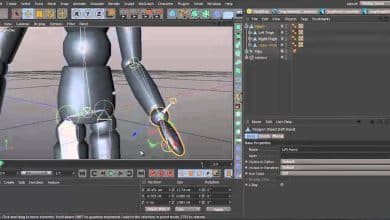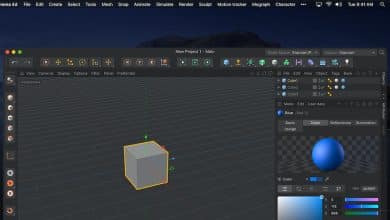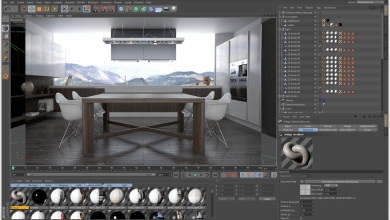Two of the most popular tools in the world of 3D modeling and animation are Blender, a free and open-source 3D modeling software, and Cinema 4D, a professional 3D software known for its accessibility and power in motion graphics. While each tool can be used independently, many artists and designers find themselves needing to open Blender files in Cinema 4D for an array of reasons – from leveraging specific features to collaborating with different teams.
The ability to move files between these two software can significantly enhance your creative process, allowing you to harness the best of both worlds. This guide seeks to demystify the process of opening Blender files in Cinema 4D, from the initial file preparation in Blender to the importing process in Cinema 4D, along with some common issues you may encounter and how to navigate them.
Key Takeaways
- Opening Blender files directly in Cinema 4D isn’t possible, but you can export Blender files in a compatible format such as
.fbxor.obj, which can be imported into Cinema 4D. - Preparing your file properly in Blender, with attention to materials, textures, and geometry, can greatly assist in a smooth transition to Cinema 4D.
- Be aware of potential issues such as missing materials or textures, deformed mesh, or incorrect scale or orientation. You may need to resolve these manually in Cinema 4D after import.
- Take advantage of the vast resources available online, including official documentation, tutorials, and user communities, to further refine your skills in moving files between Blender and Cinema 4D.
How to Open Blender Files in Cinema 4D
It’s not a straight journey when it comes to opening Blender files in Cinema 4D due to different native file formats: .blend for Blender and .c4d for Cinema 4D. That being said, with the correct method and a few necessary steps, this process can be made seamless. Here’s a complete guide to help you navigate this procedure.
Step 1: Exporting Blender Files
To begin, you’ll need to export your Blender file in a format that Cinema 4D can interpret. Here are the steps to export a .blend file into .fbx or .obj formats, both of which are compatible with Cinema 4D.
- Open your Blender project: Start by opening your Blender project. After it’s open, ensure that everything is as you want it to be before moving on to the next step.
- Select the objects to export: If you don’t want to export everything in your project, select the objects you want to export. You can do this by holding down the
Shiftkey and right-clicking on each object. - Go to File > Export: In the top left corner of your Blender interface, click on
File, then scroll down and selectExport. A submenu will open to the right. - Choose the export format: From the submenu, select either
FBX (.fbx)orWavefront (.obj). - Name and save your file: After you’ve chosen the format, a window will open that allows you to choose the location and name your file. After you’ve done this, click on
Export FBXorExport OBJ.
Remember that exporting animations may require additional settings, such as baking animations before exporting in FBX format. Also, when exporting materials, make sure they’re compatible with Cinema 4D or be prepared to recreate them.
Step 2: Importing Blender Files into Cinema 4D
Once you’ve successfully exported your Blender file, it’s time to import it into Cinema 4D.
- Open Cinema 4D: Start by launching the Cinema 4D application on your computer.
- Go to File > Merge: Once Cinema 4D is open, click on
Filein the top left corner of your interface, then selectMerge. - Select the Blender file: A window will open that allows you to navigate to your saved Blender file (now an
.fbxor.objfile). Select your file and clickOpen. - Set import settings: Before your file is officially imported, a settings window will open. Here, you can adjust the scale, orientation, and other parameters. For most Blender exports, the default settings will work just fine. After checking the settings, click
OK. - Adjust the scene as needed: After importing, your Blender file should now be open in Cinema 4D. At this point, you can adjust the scene, modify the materials, animate objects, or do whatever else you need to with your file.
Problems You Might Encounter
There may be some issues that you might face during this process, mostly due to the conversion from one software to another. Some of these potential problems include:
- Loss of Material or Textures: Depending on the complexity of the materials in Blender, some may not transfer perfectly into Cinema 4D. In such cases, you may need to recreate or modify them in Cinema 4D.
- Deformation of Mesh: In some cases, particularly with complex geometries, you may notice some deformations or anomalies in the mesh after importing into Cinema 4D. To correct this, you might need to revisit the geometry in Blender, simplify it, or clean it up before exporting again.
- Incorrect Scale or Orientation: Sometimes, you might find that the scale or orientation of the models is not correctly transferred. Be ready to adjust these manually in Cinema 4D after importing.
Tips to Optimize Your Workflow Between Blender and Cinema 4D
To help you mitigate the potential problems and streamline the process of opening Blender files in Cinema 4D, here are some tips:
- Optimize Your Blender File Before Export: Make sure your objects in Blender are clean and well-organized. Remove any unnecessary geometry, check the normals, and make sure the textures and materials are correctly assigned.
- Consistent Scale and Units: Ensure you are using consistent units and scales in both Blender and Cinema 4D. This can greatly help in maintaining the correct size and proportions when moving files between the two programs.
- Use Compatible Material and Texture Settings: As materials and textures can sometimes get lost or distorted in the process, it’s best to use settings that are compatible in both Blender and Cinema 4D, or be prepared to do some adjustments post-import in Cinema 4D.
FAQ: How to Open Blender Files in Cinema 4D
1. Can you open Blender files in Cinema 4D?
Directly opening .blend files in Cinema 4D is not possible as both software use different native file formats. However, there’s a workaround – export the Blender file as an .fbx or .obj, which can be imported into Cinema 4D.
2. How do I import files into Cinema 4D?
Importing files into Cinema 4D involves a few steps. First, go to File > Merge. A window will appear, letting you navigate to the file you want to import. Select the file and click Open. An import settings window will appear. Adjust the settings as needed and click OK. Your file is now imported into Cinema 4D.
3. What file types can Cinema 4D Open?
Cinema 4D can open a variety of file types, including its native .c4d files, .fbx, .obj, .3ds, .dae (Collada), .stl, and more. Note that the compatibility might depend on the version of Cinema 4D you’re using.
4. How do I convert a Blender file?
To convert a Blender file, you need to export it in a different format. Go to File > Export, select the desired format, and name your file. Click Export, and your Blender file will be converted into the chosen format.
5. Is Cinema 4D easier than Blender?
The ease of use between Cinema 4D and Blender may vary depending on the user’s experience and needs. Some users find Cinema 4D’s user interface and intuitive tools easier to understand, while others prefer the versatility and powerful features of Blender, which is open-source.
6. How do I open a Cinema 4D?
To open Cinema 4D, simply locate the application on your computer and double click on it. If you’re opening a specific Cinema 4D file, you can do so by launching the program, then going to File > Open, and selecting the .c4d file you wish to open.
7. Can Cinema 4D Open OBJ files?
Yes, Cinema 4D can open .obj files. To do so, go to File > Merge, then select your .obj file from your computer’s file explorer. Click Open, adjust the import settings as needed, and your .obj file will be imported into Cinema 4D.
8. How do I import multiple obj into Cinema 4D?
You can import multiple .obj files into Cinema 4D in the same way you import a single .obj file. Go to File > Merge, and select multiple files by holding down the Ctrl (on Windows) or Command (on macOS) key while selecting the files. Click Open to import them all at once.
9. How do I import an Illustrator file into Cinema 4D?
To import an Adobe Illustrator file into Cinema 4D, go to File > Merge and select your .ai file. In the import settings window that appears, ensure that Connect Splines and Scale are set appropriately. Click OK to import your Illustrator file into Cinema 4D.
10. How do I convert Cinema 4D to 3ds Max?
To convert a Cinema 4D file to a format usable by 3ds Max, you’ll need to export the file from Cinema 4D in a compatible format such as .fbx or .obj. In Cinema 4D, go to File > Export and select either FBX (.fbx) or Wavefront (.obj). You can then import this file into 3ds Max.
11. Can Unity open C4D files?
Unity doesn’t support native .c4d files. However, you can export your Cinema 4D file as an .fbx file, which is fully supported by Unity. This allows you to utilize your Cinema 4D work within Unity projects.
12. How do you convert C4D to FBX?
To convert a .c4d file to .fbx, open your file in Cinema 4D and then go to File > Export > FBX (.fbx). Select the location to save your file, give it a name, and click OK.
13. How do I convert a Blender file to MP4?
To convert a Blender file to .mp4, you need to render an animation in Blender. Go to the Output Properties tab and select FFmpeg video from the dropdown menu. Under Encoding, select MPEG-4 as the container. Render the animation and it will be saved as an .mp4 file.
14. What types of files can Blender open?
Blender supports a variety of file formats. These include its native .blend files, .obj, .fbx, .3ds, .dae (Collada), .stl, and more. It can also import images and video files for texturing and compositing.
15. Does Blender support FBX?
Yes, Blender supports .fbx files. You can import and export .fbx files by going to File > Import or File > Export and selecting FBX (.fbx) from the dropdown menu.
16. Can you animate in Cinema 4D?
Yes, you certainly can. Cinema 4D offers a robust suite of tools for 3D animation, including character rigging, motion capture, keyframing, and procedural animation tools.
17. Can Blender files be imported to other software?
Yes, Blender files can be exported to various formats (like .obj or .fbx) that can be imported into many different 3D software applications including Cinema 4D, 3ds Max, Maya, and Unity.
18. Is it possible to maintain materials when transferring from Blender to Cinema 4D?
While it’s possible to export materials from Blender and import them into Cinema 4D, some complex materials might not transfer perfectly due to differences in how the two software handle materials. You may need to adjust or recreate them in Cinema 4D.
19. How can I ensure my model’s scale is maintained when moving from Blender to Cinema 4D?
Before exporting from Blender, ensure you’re using the same units as in Cinema 4D. You can check this in the Scene Properties tab in Blender and the Project Settings in Cinema 4D.
20. Can you transfer animations from Blender to Cinema 4D?
Yes, it’s possible by exporting the animation from Blender as an .fbx file, which can then be imported into Cinema 4D. However, complex animations may require additional settings or adjustments to be accurately transferred.
Conclusion
Understanding how to open Blender files in Cinema 4D can significantly streamline your 3D design workflow. This process, while initially might seem daunting, can be smoothly achieved by following the guidelines and steps provided in this article. Remember, preparation is key. Taking the time to properly prepare your Blender files before exporting can greatly assist in mitigating potential issues during the import process in Cinema 4D.
In this ever-evolving digital age, the ability to utilize multiple software tools in harmony is an invaluable skill. By mastering the art of moving files between Blender and Cinema 4D, you are opening up a world of creative possibilities, giving you the ability to harness the strengths of both software to create stunning, dynamic 3D designs.
Remember, opening Blender files in Cinema 4D may not always be a straightforward process due to the different formats and software architectures. But with the above guide and resources, you should be well-equipped to tackle this task. Good luck on your 3D journey!







